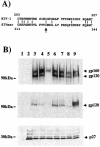Amino acid 324 in the simian immunodeficiency virus SIVmac V3 loop can confer CD4 independence and modulate the interaction with CCR5 and alternative coreceptors
- PMID: 15016843
- PMCID: PMC371062
- DOI: 10.1128/jvi.78.7.3223-3232.2004
Amino acid 324 in the simian immunodeficiency virus SIVmac V3 loop can confer CD4 independence and modulate the interaction with CCR5 and alternative coreceptors
Abstract
The V3 loop of the simian immunodeficiency virus (SIV) envelope protein (Env) largely determines interactions with viral coreceptors. To define amino acids in V3 that are critical for coreceptor engagement, we functionally characterized Env variants with amino acid substitutions at position 324 in V3, which has previously been shown to impact SIV cell tropism. These changes modulated CCR5 engagement and, in some cases, allowed the efficient usage of CCR5 in the absence of CD4. The tested amino acid substitutions had highly differential effects on viral infectivity. Eleven of sixteen substitutions disrupted entry via CCR5 or the alternative coreceptor GPR15. Nevertheless, most of these variants replicated in the macaque T-cell line 221-89 and some also replicated in rhesus macaque peripheral blood monocytes, suggesting that efficient usage of CCR5 and GPR15 on cell lines is not a prerequisite for SIV replication in primary cells. Four variants showed enhanced entry into the macaque sMagi reporter cell line. However, sMagi cells did not express appreciable amounts of CCR5 and GPR15 mRNA, and entry into these cells was not efficiently blocked by a small-molecule CCR5 antagonist, suggesting that sMagi cells express as-yet-unidentified entry cofactors. In summary, we found that a single amino acid at position 324 in the SIV Env V3 loop can modulate both the efficiency and the types of coreceptors engaged by Env and allow for CD4-independent fusion in some cases.
Figures





Similar articles
-
Coreceptor-dependent inhibition of the cell fusion activity of simian immunodeficiency virus Env proteins.J Virol. 2000 Jul;74(13):6217-22. doi: 10.1128/jvi.74.13.6217-6222.2000. J Virol. 2000. PMID: 10846110 Free PMC article.
-
CXCR6-Mediated Simian Immunodeficiency Virus SIVagmSab Entry into Sabaeus African Green Monkey Lymphocytes Implicates Widespread Use of Non-CCR5 Pathways in Natural Host Infections.J Virol. 2017 Jan 31;91(4):e01626-16. doi: 10.1128/JVI.01626-16. Print 2017 Feb 15. J Virol. 2017. PMID: 27903799 Free PMC article.
-
Decreased plasticity of coreceptor use by CD4-independent SIV Envs that emerge in vivo.Retrovirology. 2013 Nov 12;10:133. doi: 10.1186/1742-4690-10-133. Retrovirology. 2013. PMID: 24219995 Free PMC article.
-
SIV Coreceptor Specificity in Natural and Non-Natural Host Infection: Implications for Cell Targeting and Differential Outcomes from Infection.Curr HIV Res. 2018;16(1):41-51. doi: 10.2174/1570162X15666171124121805. Curr HIV Res. 2018. PMID: 29173179 Review.
-
The SIV Envelope Glycoprotein, Viral Tropism, and Pathogenesis: Novel Insights from Nonhuman Primate Models of AIDS.Curr HIV Res. 2018;16(1):29-40. doi: 10.2174/1570162X15666171124123116. Curr HIV Res. 2018. PMID: 29173176 Review.
Cited by
-
Lineage-specific differences between human and simian immunodeficiency virus regulation of gp120 trimer association and CD4 binding.J Virol. 2012 Sep;86(17):8974-86. doi: 10.1128/JVI.01076-12. Epub 2012 Jun 13. J Virol. 2012. PMID: 22696649 Free PMC article.
-
Boosting of ALVAC-SIV Vaccine-Primed Macaques with the CD4-SIVgp120 Fusion Protein Elicits Antibodies to V2 Associated with a Decreased Risk of SIVmac251 Acquisition.J Immunol. 2016 Oct 1;197(7):2726-37. doi: 10.4049/jimmunol.1600674. Epub 2016 Sep 2. J Immunol. 2016. PMID: 27591322 Free PMC article.
-
Lineage-Specific Differences between the gp120 Inner Domain Layer 3 of Human Immunodeficiency Virus and That of Simian Immunodeficiency Virus.J Virol. 2016 Oct 28;90(22):10065-10073. doi: 10.1128/JVI.01215-16. Print 2016 Nov 15. J Virol. 2016. PMID: 27535053 Free PMC article.
-
Derivation and characterization of a simian immunodeficiency virus SIVmac239 variant with tropism for CXCR4.J Virol. 2009 Oct;83(19):9911-22. doi: 10.1128/JVI.00533-09. Epub 2009 Jul 15. J Virol. 2009. PMID: 19605489 Free PMC article.
-
Simian immunodeficiency virus infects follicular helper CD4 T cells in lymphoid tissues during pathogenic infection of pigtail macaques.J Virol. 2013 Apr;87(7):3760-73. doi: 10.1128/JVI.02497-12. Epub 2013 Jan 16. J Virol. 2013. PMID: 23325697 Free PMC article.
References
-
- Berger, E. A., P. M. Murphy, and J. M. Farber. 1999. Chemokine receptors as HIV-1 coreceptors: roles in viral entry, tropism, and disease. Annu. Rev. Immunol. 17:657-700. - PubMed
-
- Chackerian, B., N. L. Haigwood, and J. Overbaugh. 1995. Characterization of a CD4-expressing macaque cell line that can detect virus after a single replication cycle and can be infected by diverse simian immunodeficiency virus isolates. Virology 213:386-394. - PubMed
Publication types
MeSH terms
Substances
LinkOut - more resources
Full Text Sources
Molecular Biology Databases
Research Materials

